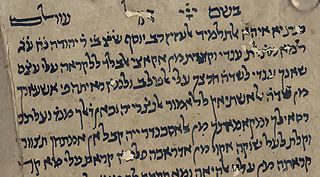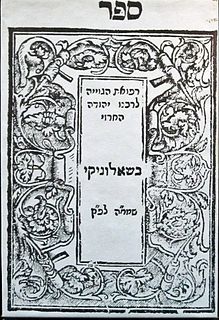Related Research Articles
Jacob ben Abba Mari ben Simson Anatoli was a translator of Arabic texts to Hebrew. He was invited to Naples by Frederick II. Under this royal patronage, and in association with Michael Scot, Anatoli made Arabic learning accessible to Western readers. Among his most important works were translations of texts by Averroes.

Moses ben Maimon (1138–1204), commonly known as Maimonides and also referred to by the acronym Rambam, was a medieval Sephardic Jewish philosopher who became one of the most prolific and influential Torah scholars of the Middle Ages. In his time, he was also a preeminent astronomer and physician, serving as the personal physician of Saladin. Born in Córdoba, Almoravid Empire, on Passover eve, 1138, he worked as a rabbi, physician and philosopher in Morocco and Egypt. He died in Egypt on 12 December 1204, whence his body was taken to the lower Galilee and buried in Tiberias.

Jewish philosophy includes all philosophy carried out by Jews, or in relation to the religion of Judaism. Until modern Haskalah and Jewish emancipation, Jewish philosophy was preoccupied with attempts to reconcile coherent new ideas into the tradition of Rabbinic Judaism, thus organizing emergent ideas that are not necessarily Jewish into a uniquely Jewish scholastic framework and world-view. With their acceptance into modern society, Jews with secular educations embraced or developed entirely new philosophies to meet the demands of the world in which they now found themselves.

The Kuzari, full title Book of Refutation and Proof on Behalf of the Despised Religion, also known as the Book of the Khazar, is one of the most famous works of the medieval Spanish Jewish philosopher and poet Judah Halevi, completed in the Hebrew year 4900 (1139-40CE).

Samuel ben Judah ibn Tibbon, more commonly known as Samuel ibn Tibbon, was a Jewish philosopher and doctor who lived and worked in Provence, later part of France. He was born about 1150 in Lunel (Languedoc), and died about 1230 in Marseilles. He is best known for his translations of Jewish rabbinic literature from Arabic to Hebrew.

Medieval Hebrew was a literary and liturgical language that existed between the 4th and 19th century. It was not commonly used as a spoken language, but mainly in written form by rabbis, scholars and poets. Medieval Hebrew had many features that distinguished it from older forms of Hebrew. These affected grammar, syntax, sentence structure, and also included a wide variety of new lexical items, which were either based on older forms or borrowed from other languages, especially Aramaic, Greek and Latin.

The Guide for the Perplexed is a work of theology by Maimonides. It seeks to reconcile Aristotelianism with Rabbinical Jewish theology by finding rational explanations for many events in the text.

Yehuda Alharizi, also Judah ben Solomon Harizi or al-Harizi, was a rabbi, translator, poet and traveller active in Spain in the Middle Ages. He was supported by wealthy patrons, to whom he wrote poems and dedicated compositions.

Abraham Maimonides was the son of Maimonides who succeeded his father as Nagid of the Egyptian Jewish community.

Vayelech, Vayeilech, VaYelech, Va-yelech, Vayelekh, Wayyelekh, Wayyelakh, or Va-yelekh is the 52nd weekly Torah portion in the annual Jewish cycle of Torah reading and the ninth in the Book of Deuteronomy. It constitutes Deuteronomy 31:1–30. In the parashah, Moses told the Israelites to be strong and courageous, as God and Joshua would soon lead them into the Promised Land. Moses commanded the Israelites to read the law to all the people every seven years. God told Moses that his death was approaching, that the people would break the covenant, and that God would thus hide God's face from them, so Moses should therefore write a song to serve as a witness for God against them.
Haazinu, Ha'azinu, or Ha'Azinu is the 53rd weekly Torah portion in the annual Jewish cycle of Torah reading and the 10th in the Book of Deuteronomy. It constitutes Deuteronomy 32:1–52. The parashah sets out the Song of Moses — an indictment of the Israelites' sins, a prophecy of their punishment, and a promise of God's ultimate redemption of them.

Shem-Tov ben Joseph ibn Falaquera, also spelled Palquera was a Spanish Jewish philosopher and poet and commentator. A vast body of work is attributed to Falaquera, including encyclopedias of Arabic and Greek philosophies, maqamas, some 20,000 poetic verses, and commentaries on Maimonides’ Guide to the Perplexed. The common theme in Falaquera’s writing was to encourage observant Jews to study philosophy and to appreciate the harmony that existed between Torah and rational truth learned in philosophy. While Falaquera did not advocate teaching the secrets of science and divine sciences to every man, he did advocate the teaching of these truths to a broader range of educated Jewish males than previous proponents of rationalist thinking.

Yehezkel Kaufmann was an Israeli philosopher and Biblical scholar associated with the Hebrew University. His main contribution to the study of biblical religion was his thesis that Israel's monotheism was not a gradual development from paganism but entirely new.
Joshua ben Joseph ibn Vives al-Lorqui was a Spanish-Jewish physician who lived at Alcañiz. In 1408, at the command of the rich and influential Benveniste ben Solomon ben Labi, he wrote a work in Arabic on the value and effects of various foodstuffs and of simple and composite medicaments. It was translated into Hebrew, under the title Gerem ha-Ma'alot, by Benveniste's son, Joseph Vidal.
Joseph ben Abba Meir ben Joseph ben Jacob Caspi, also known as Yosef ibn Caspi, was a Provençal exegete, grammarian, and philosopher, apparently influenced by Averroës.
Moses ibn Tibbon was a Jewish physician, author and translator in Provence. The number of works written by Moses ibn Tibbon suggest that he reached a great age.

Joseph ben Judah of Ceuta was a Jewish physician and poet, and disciple of Moses Maimonides. Maimonides wrote his work, the Guide for the Perplexed for Joseph.
Jewish Kalam was an early medieval style of Jewish philosophy that evolved in response to Kalam in Islam, which in turn was a reaction against Aristotelianism.
Joseph ben Judah ibn Aknin was a Sephardic Jewish writer of numerous treatises, mostly on the Mishnah and the Talmud. He was born in Barcelona, but settled in Fes, where by his own admission he lived as a crypto-Jew. Though a native of Spain, his family had originated in North Africa.
Shi’ur Qomah is a Midrashic text that is part of the Heichalot literature. It purports to record, in anthropomorphic terms, the secret names and precise measurements of God's corporeal limbs and parts. The majority of the text is recorded in the form of sayings or teachings that the angel Metatron revealed to the Tannaic Sage, Rabbi Yishmael who transmitted it to his students and his contemporary Rabbi Akiva. It is also an exegetical analysis of Song of Songs 5:11-16 and proclaims that anyone who studies it is guaranteed a portion in Olam HaBa.
References
- ↑ Remark in Colette Sirat, Nicholas de Lange (2002), Hebrew manuscripts of the Middle Ages , Cambridge: Cambridge University Press. ISBN 0-521-77079-3. p. 284
- ↑ Quoted in Michael Friedländer (1904), The Guide for the Perplexed by Moses Maimonides (2e)
- ↑ Remark in Colette Sirat (1990), A History of Jewish Philosophy in the Middle Ages , Cambridge: Cambridge University Press. ISBN 0-521-39727-8. p. 208
- ↑ Remark in Herbert Alan Davidson (2005), Moses Maimonides , Oxford: Oxford University Press. ISBN 0-19-517321-X. p. 426